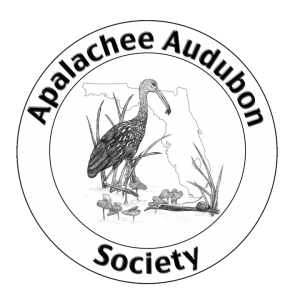Register for this event via Mobilize.
4:00 PM, informal bird walk and social hour.
5:00 PM, Dinner, Annual Meeting, Election
6:00 PM, Presentation. You are welcome to join us virtually if you can’t make it to the dinner. We are also planning to livestream it. Click here to register via Zoom.
Here are the logistics:
GATHER at the Miccosukee Land Co-op Community Room building as early as 4:00 PM for informal birding and socializing. Do bring your binoculars!
SUPPER will begin at 5:00 PM so please have your covered dish there—one per person or family— by that time. Please bring a serving spoon. Label your serving dishes and spoons. Please also bring an index card with the name of your covered dish. Mention on the card whether it is vegan, vegetarian, gluten free or if it has nuts in it. AAS will supply ice cold minted water, iced tea, and lemonade.
LET’S SEE HOW LITTLE WASTE WE GENERATE Each person should bring their own plate, bowl, utensils and cup or water bottle. If you forget, we will have extras on hand. We also recommend bringing a cloth napkin and a washable cloth bag in which to stow your used dishes. Sustainability starts with us. We’re looking forward to seeing you there.
Beyond Sight and Sound: Exploring scent cues in birds
with Pearl Rivers Key, PhD
Do birds have a sense of smell? The dazzling colors, intricate dance moves, and elaborate vocalizations of avian courtship are well known. However, until relatively recently, birds were thought to have a poor sense of smell. Growing evidence now suggests that scent and other chemical cues play a significant role in bird courtship and reproduction, yet their function in species with visually and acoustically elaborate displays remains largely unexplored. In her talk, Pearl will trace the history of research on avian olfaction and examine how chemical cues influence bird behavior. Pearl will also share insights from her dissertation research on the role of chemical communication in the mating behaviors of her favorite bird, the lance-tailed manakin.
To some birds, the whiff of certain fragrances is like the sight of the Golden Arches: a sure sign of lunch. To others, following scents may be as good as reading a road map, since smell helps them navigate the skies. All birds possess some of the sensory equipment necessary for perceiving odors, but whether all use it is an age-old question. Read more at Audubon Magazine.
Pearl Rivers Key, PhD
Dr. Pearl Rivers Key is a Postdoctoral Scholar in the Department of Biological Science at Florida State University. Pearl is a behavioral ecologist: she studies why animals behave the way they do in their natural environment, and how behaviors influence survival and reproduction. During her Ph.D. research at FSU, she studied mate choice in lance-tailed manakins (Chiroxiphia lanceolata), a small neotropical bird. By watching these birds in the wild, running experiments, and using genetic tools, she learned more about the information that females use when choosing a mate. Now, as a postdoctoral researcher, she studies sea urchins to see how processes that affect reproductive compatibility between males and females can play a role in the evolution of new species. In addition to her research, Pearl enjoys mentoring undergraduate students, organizing writing groups, and getting involved in science outreach. She also helps advocate for postdoctoral researchers and promote engagement in postdoctoral affairs at Florida State University and is the current Vice President of the FSU Postdoctoral Association.
Lance-tailed Manakin By Greg Kanies
CC BY-SA 2.0, https://commons.wikimedia.org/w/index.php?curid=45187733


